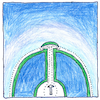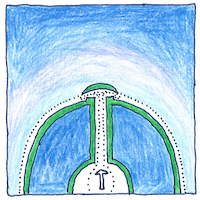Henri Coandă
aerodynamics

|
Coandă effect
A stream of air entrains the air around it pulling molecules into its path. This entrainment lowers the pressure of the surrounding air so that lower pressure sucks the airstream to a nearby surface and atmospheric pressure pushes the surface toward its low-pressure side.
Identified flying objects
The Coandă-1910 aircraft. The VZ-9 AV Avrocar. The Boeing YC-14. The McDonnell Douglas YC-15. The Boeing C-17. The NOTAR helicopter. The Antonov An-72 “Coaler.” The Shin Meiwa US-1A flying boat. The Blackburn Buccaneer. The C-17 Globemaster III.
Coandă and Bernoulli
When air flows under a wing more slowly than above the wing, the wing gets a lift by Bernoull’s principle. When a layer of air flows over the top of a wing more quickly than the air above it, the wing gets a lift by the Coandă effect.
Arguments
The six blind men who felt the elephant naturally were in total disagreement. Meanwhile, every passer by who could see believed he saw the elephant as a whole.



In 1800, Thomas Young found that a convex surface deflected a jet of air from a blowpipe. Some describe the Coandă effect simply as the tendency of an airstream to stay attached a convex surface. Adherence to a concave surface does not directly provide lift. Without a nearby surface, an airstream lowers the air pressure all around it. When it adheres to a surface, it lowers air pressure only on its open side. When it adheres to the top of a wing, the higher air pressure on the bottom lifts the wing. When it adheres to the bottom of a wing, the higher air pressure on the top pulls the wing down. In flight, the Coandă effect occurs only when the adhered airstream moves faster than the air above it. The result of deflecting an airstream (up or down) is separate from the Coandă effect,
See also in The book of science:
Readings in wikipedia: